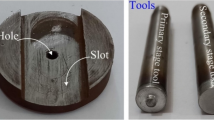Abstract
Friction stir welding is a solid-state welding technology capable of joining metal parts without melting. The microstructure of the material evolved during the process from columnar grain along the thermal gradient in the melt pool to fine equiaxed grains. A significant decrease in microhardness in the stir zone was observed with the lowest hardness at approximately 3 mm from the weld centre. The decrease in the microhardness is mainly attributed to the dissolution of hardening precipitates in the aluminium matrix. Defects in the weld were observed due to insufficient heat input. Heat input could be increased with the increase in rotational speed of the welding tool, with some improvements in strength.








Similar content being viewed by others
References
Rhodes CG, Mahoney MW, Bingel WH, Spurling RA, Bampton CC (1997) Effects of friction stir welding on microstructure of 7075 aluminum. Scr Mater 36(1):69–75
Liu G, Murr LE, Niou CS, McClure JC, Vega FR (1997) Microstructural aspects of the friction-stir welding of 6061-T6 aluminum. Scr Mater 37(3):355–361
Jata KV, Sankaran KK, Ruschau JJ (2000) Friction-stir welding effects on microstructure and fatigue of aluminum alloy 7050-T7451. Metall Mater Trans A 31(9):2181–2192
Jhabvala J, Boillat E, Antignac T, Glardon R (2010) On the effect of scanning strategies in the selective laser melting process. Virtual and Physical Prototyping 5(2):99–109
Su J-Q, Nelson TW, Sterling CJ (2005) Microstructure evolution during FSW/FSP of high strength aluminum alloys. Mater Sci Eng A 405(1–2):277–286
Fonda RW, Knipling KE, Bingert JF (2008) Microstructural evolution ahead of the tool in aluminum friction stir welds. Scr Mater 58(5):343–348
Humphreys F.J. and Hatherly M., Chapter 11 - Grain growth following recrystallization, ed. R.a.R.A.P.S. Edition). 2004, Oxford: Elsevier Ltd
Mishra R.S. and Ma Z.Y., Friction stir welding and processing. Materials Science and Engineering: R: Reports, 2005. 50(1–2): p. 1-78
Sato YS, Urata M, Kokawa H (2002) Parameters controlling microstructure and hardness during friction-stir welding of precipitation-hardenable aluminum alloy 6063. Metall Mater Trans A 33(3):625–635
Arbegast W.J., Hot deformation of aluminum alloys III, ed. Z. Jin, A. Beaudoin, T.A. Bieler, and B. Radhakrishnan. 2003: Wiley
Hales SJ, McNelley TR (1988) Microstructural evolution by continuous recrystallization in a superplastic Al-Mg alloy. Acta Metall 36(5):1229–1239
Gudmundsson H, Brooks D, Wert JA (1991) Mechanisms of continuous recrystallization in an Al ☐ Zr ☐ Si alloy. Acta Metall Mater 39(1):19–35
Du Z, Tan MJ, Guo JF, Wei J (2016) Aluminium-carbon nanotubes composites produced from friction stir processing and selective laser melting. Mater Werkst 47(5–6):539–548
Guo J.F., Liu J., Sun C.N., Maleksaeedi S., Bi G., Tan M.J., and Wei J., Effects of nano-Al2O3 particle addition on grain structure evolution and mechanical behaviour of friction-stir-processed Al. Mater Sci Eng A, 2014. 602(0): p. 143–149
Al-Fadhalah K.J., Almazrouee A.I., and Aloraier A.S., Microstructure and mechanical properties of multi-pass friction stir processed aluminum alloy 6063. Materials & Design, 2014. 53(0): p. 550–560
Sato YS, Kokawa H, Enomoto M, Jogan S (1999) Microstructural evolution of 6063 aluminum during friction-stir welding. Metall Mater Trans A 30(9):2429–2437
Du Z, Tan MJ, Guo JF, Bi G, Wei J (2016) Fabrication of a new Al-Al2O3-CNTs composite using friction stir processing (FSP). Mater Sci Eng A 667:125–131
Takahara H, Tsujikawa M, Chung SW, Okawa Y, Higashi K, Oki S (2008) Optimization of welding condition for nonlinear friction stir welding. Mater Trans 49(6):1359–1364
Kwon Y, Saito N, Shigematsu I (2002) Friction stir process as a new manufacturing technique of ultrafine grained aluminum alloy. J Mater Sci Lett 21(19):1473–1476
Martin J.W., Micromechanisms in particle-hardened alloys. 1980: CUP Archive
Committee A.h., Properties and selection: nonferros alloys and special-purpose materials. 1991, Materials Park, OH: ASM International
Author information
Authors and Affiliations
Corresponding author
Additional information
This article is part of the collection Welding, Additive Manufacturing and Associated NDT.
Rights and permissions
About this article
Cite this article
Du, Z., Tan, M.J., Chen, H. et al. Joining of 3D-printed AlSi10Mg by friction stir welding. Weld World 62, 675–682 (2018). https://doi.org/10.1007/s40194-018-0585-7
Received:
Accepted:
Published:
Issue Date:
DOI: https://doi.org/10.1007/s40194-018-0585-7




